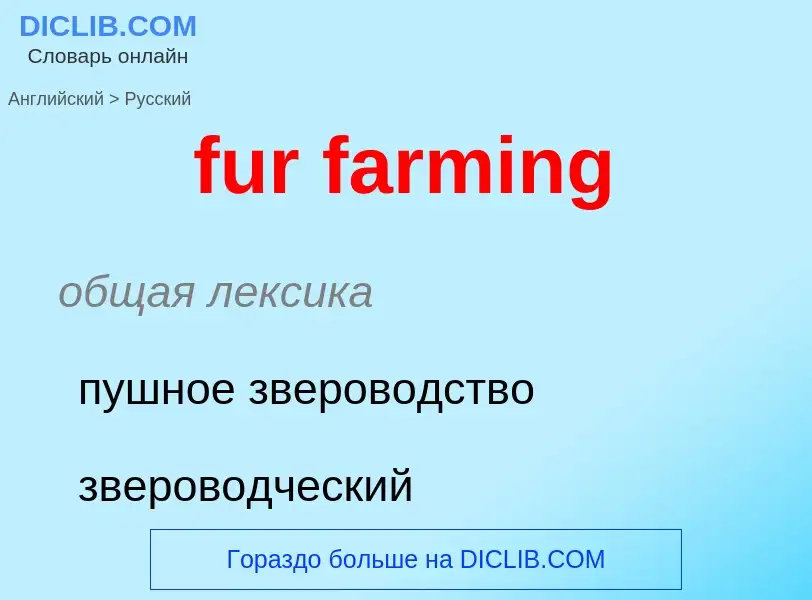Перевод и анализ слов искусственным интеллектом ChatGPT
На этой странице Вы можете получить подробный анализ слова или словосочетания, произведенный с помощью лучшей на сегодняшний день технологии искусственного интеллекта:
- как употребляется слово
- частота употребления
- используется оно чаще в устной или письменной речи
- варианты перевода слова
- примеры употребления (несколько фраз с переводом)
- этимология
fur farming - перевод на русский
общая лексика
пушное звероводство
звероводческий
['pelidʒ]
общая лексика
меховой покров
волосяной покров
существительное
общая лексика
меховой покров
волосяной покров
мех, шкура, шерсть (животных)
['fə:be(ə)rə]
существительное
общая лексика
пушной зверь
['fə:lɔŋ(z)]
общая лексика
мех
шкурка
меховой
шерсть
пушок (на плодах)
пушной зверь
пушнина
шуба
шубный
сокращение
от furlong
существительное
[fə:]
общая лексика
мех
шерсть
шкура
шкурка
пушнина
меха
меховые изделия
пушок (на плодах и т. п.)
накипь (в котле и т. п.)
осадок (в винной бочке)
шерсть, шкура
налет (на языке больного)
накипь (в котле, трубах)
осадок (в винных бочках)
меховой
собирательное выражение
пушной зверь
медицина
налёт (на языке)
строительное дело
обрешётка
глагол
общая лексика
преим. past participle отделывать
подбивать мехом
покрывать накипью или налётом
покрываться накипью или налётом
счищать накипь (с котла)
подбивать или отделывать мехом
счищать накипь (в котле)
строительное дело
обшивать рейками
дранью
досками
обшивать рейками, дранью или досками
[pelt]
общая лексика
шкура
кожа
шкурка
существительное
[pelt]
общая лексика
шкура
кожа
шкурка (в меховом производстве)
бросание
швыряние
сильный удар
стук дождя или града
бросание, швыряние
стук дождя, града
шутливое выражение
человеческая кожа
диалектизм
вспышка гнева
отбросы
геология
нечистый
кеннельский уголь
глагол
[pelt]
общая лексика
бросать
швырять (в кого-л.)
забрасывать (камнями, грязью)
(with) обрушиваться (на кого-л. с упрёками и т. п.)
стучать
барабанить (о дожде и т. п.)
бить
колотить
броситься
ринуться
бросать (в кого-л.), забрасывать (камнями, грязью)
обстреливать
колотить, барабанить (о граде и т. п.)
лить (о дожде)
обрушиться (на кого-л. с упреками, вопросами и т. п.)
спешить
броситься, ринуться
сокращение
[failure and unsatisfactory report] донесение об отказах и неудовлетворительной работе
[failure or unsatisfactory report] донесение об отказах или неудовлетворительной работе
[failure, unsatisfactory or removal] отказ, неудовлетворительная работа или замена
Определение
Википедия

Fur farming is the practice of breeding or raising certain types of animals for their fur.
Most of the world's farmed fur is produced by European farmers. In 2018, there were 5,000 fur farms in the EU, all located across 22 countries; these areas of production collectively accounted for 50% of the global production of farmed fur. The EU accounts for 63% of global mink production and 70% of fox production. Denmark was the leading mink-producing country, accounting for approximately 28% of world production. The top three fur producers are Denmark (formerly), Poland and China. Finland is the largest United States supplier of fox pelts. The United States is a major exporter of fur skins. Major export markets include China, Russia, Canada, and the EU. Exports to Asia as a share of total exports grew from 22% in 1998 to 47% in 2002. As of 2012, Russia was reported to be the world's biggest sales market for fur. China has been the world's largest importer of fur pelts and the largest exporter of finished fur products.
Fur farming is banned in Austria, Croatia, the United Kingdom, the Czech Republic, the Netherlands (effective March 2021), Norway (effective February 2025) and Italy (effective June 2022). In Switzerland, the regulations for fur farming are very strict, with the result that there are no fur farms. Some other countries have a ban on fur farming of certain types of animals.
Demand fell in the late 1980s and 1990s as a result of a number of factors, including the efforts of animal rights campaigners and the failure of designers to come up with exciting new lines. Since the turn of the millennium, however, sales worldwide have soared to record highs, fueled by radically new techniques for working with fur, and a sharp rise in disposable income in China and Russia. This growing demand has led to the development of extensive fur farming operations in China and Poland.
During the COVID-19 pandemic, mink turned out to be very susceptible to human–mink infection, sparking fears of widespread outbreaks and mutations in the mink farm populations of many countries that could in turn infect humans with different strains of the coronavirus, making it potentially immune for a COVID-19 vaccine. Several mink farms in the Netherlands have been entirely culled since June 2020, and in August 2020 the phaseout of fur farming was accelerated from 1 January 2024 to 1 March 2021. In July 2020, Spain culled 100,000 mink. On 6 November 2020, Denmark announced it would cull its entire 17 million mink population as an emergency to prevent the spread of a mutated strain of COVID-19, of which at least five cases were found. On 11 November, the Netherlands again moved the phase-out forward, now putting 1 January 2021 as the target date to limit the risk of mutation. Kopenhagen Fur (accounting for 40% of mink production worldwide) announced mid-November it would gradually cease operations in 2–3 years because the circumstances had critically undermined the future of the global fur trade.



 fur skins.jpg?width=200)
![A mink farm in [[Poland]] A mink farm in [[Poland]]](https://commons.wikimedia.org/wiki/Special:FilePath/Ferma norek w Polsce.jpg?width=200)
![Cross fox]]" furs. The cross across the shoulders is a common [[red fox]] marking. Cross fox]]" furs. The cross across the shoulders is a common [[red fox]] marking.](https://commons.wikimedia.org/wiki/Special:FilePath/Fur crossfox.jpg?width=200)



![A [[mink]] farm (after 1900) A [[mink]] farm (after 1900)](https://commons.wikimedia.org/wiki/Special:FilePath/Mink farm 1908.jpg?width=200)

![(silver morph)]] (silver morph)]]](https://commons.wikimedia.org/wiki/Special:FilePath/Silver fox.jpg?width=200)
.jpg?width=200)

![[[Opossum]] fur [[Opossum]] fur](https://commons.wikimedia.org/wiki/Special:FilePath/Opossum fur.jpg?width=200)

![The iconic [[bearskin]]s of the [[Queen's Guard]] at Buckingham Palace are made from the fur of [[American black bear]]s. The iconic [[bearskin]]s of the [[Queen's Guard]] at Buckingham Palace are made from the fur of [[American black bear]]s.](https://commons.wikimedia.org/wiki/Special:FilePath/Buckingham-palace-guard-11279634947G5ru.jpg?width=200)
![USAF]] pilot and Arctic explorer USAF]] pilot and Arctic explorer](https://commons.wikimedia.org/wiki/Special:FilePath/Carl Eielson.jpg?width=200)
![A fur store in [[Tallinn]], Estonia, in 2019 A fur store in [[Tallinn]], Estonia, in 2019](https://commons.wikimedia.org/wiki/Special:FilePath/Pelz-Verkaufsstand in Tallinn, Estland.jpg?width=200)
